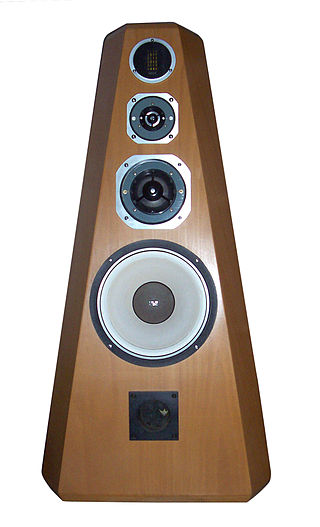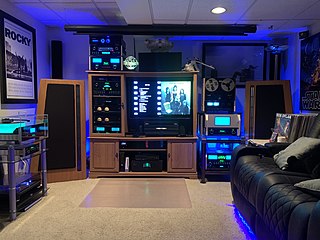
High fidelity is the high-quality reproduction of sound. It is popular with audiophiles and home audio enthusiasts. Ideally, high-fidelity equipment has inaudible noise and distortion, and a flat frequency response within the human hearing range.

Vehicle audio is equipment installed in a car or other vehicle to provide in-car entertainment and information for the occupants. Until the 1950s, it consisted of a simple AM radio. Additions since then have included FM radio (1952), 8-track tape players, cassette players, record players, CD players, DVD players, Blu-ray players, navigation systems, Bluetooth telephone integration, and smartphone controllers like CarPlay and Android Auto. Once controlled from the dashboard with a few buttons, they can be controlled by steering wheel controls and voice commands.

A boombox is a transistorized portable music player featuring one or two cassette tape players/recorders and AM/FM radio, generally with a carrying handle. Beginning in the mid 1990s, a CD player was often included. Sound is delivered through an amplifier and two or more integrated loudspeakers. A boombox is a device typically capable of receiving radio stations and playing recorded music. Many models are also capable of recording onto cassette tapes from radio and other sources. In the 1990s, some boomboxes were available with MiniDisc recorders and players. Designed for portability, boomboxes can be powered by batteries as well as by line current. The boombox was introduced to the American market during the late 1970s. The desire for louder and heavier bass led to bigger and heavier boxes; by the 1980s, some boomboxes had reached the size of a suitcase. Some larger boomboxes even contained vertically mounted record turntables. Most boomboxes were battery-operated, leading to extremely heavy, bulky boxes.
Nakamichi Corp., Ltd. is a Japanese consumer electronics brand that originated in Japan and gained a name from the 1970s onwards for innovative and high quality audio cassette decks. Nakamichi is a subsidiary of Chinese holding company Nimble Holdings.

Sansui Electric Co., Ltd. was a Japanese manufacturer of audio and video equipment. Headquartered in Tokyo, Japan, it was part of the Bermuda conglomerate.
Marantz is a company that develops and sells high-end audio products. The company was founded in New York, but is now based in California.
Harman Kardon is a division of US-based Harman International Industries, an independent subsidiary of Samsung Electronics. Harman Kardon was originally founded in Westbury, New York, in 1953 by business partners Sidney Harman and Bernard Kardon.
Denon is a Japanese electronics company dealing with audio equipment. The Denon brand came from a merger of Denki Onkyo and others in 1939, but it originally started as Nippon Chikuonki Shoukai in 1910 by Frederick Whitney Horn, an American entrepreneur.
Alpine Electronics, Inc. is a Japanese consumer electronics subsidiary of the Japanese electronics component manufacturer Alps Electric, specialising in car audio and navigation systems.
Musical Fidelity is a British producer of high-end audio equipment focusing on streaming music players, and its core product range of amplifiers of various types. Other products have included headphones, Digital-Analog Converters (DACs), CD players, Bluetooth Receivers, ‘all-in-one systems’. Founded in the United Kingdom in 1982, they are known for their unusual industrial design, Nuvistor tube use and Class-AB amplifiers.
Armstrong Audio, originally called Armstrong Wireless and Television Ltd. was a British manufacturer of radios and other audio equipment based in London, England. Founded by Claude Charles Jackson in 1932.
Phase Linear was an audio equipment manufacturer founded by Bob Carver and Steve Johnston in 1970. While primarily known as a power amplifier company it also produced several innovative preamplifiers, tuners and the Andromeda loudspeaker.

An audio/video receiver (AVR) is a consumer electronics component used in a home theater. Its purpose is to receive audio and video signals from a number of sources, and to process them and provide power amplifiers to drive loudspeakers and route the video to displays such as a television, monitor or video projector. Inputs may come from a satellite receiver, radio, DVD players, Blu-ray Disc players, VCRs or video game consoles, among others. The AVR source selection and settings such as volume, are typically set by a remote controller.
Luxman is a brand name of Japanese Luxman Corporation (ラックスマン株式会社) that manufactures luxury audio components. Luxman produces a variety of high-end audio products, including turntables, amplifiers, receivers, tape decks, CD players and speakers.
Cambridge Audio is a British manufacturer of high-end audio equipment. As the name suggests, it has its origins in Cambridge, England, where in the early 1960s a group of young technology graduates established a high-technology R&D and prototyping business: Cambridge Consultants.
Technics is a Japanese audio brand established by Panasonic in 1965. Since 1965, Panasonic has produced a variety of hi-fi and audio products under the brand name, such as turntables, amplifiers, radio receivers, tape recorders, CD players, speakers, and digital pianos. Technics products were available for sale in various countries. The brand was originally conceived as a line of high-end audio equipment to compete against brands such as Nakamichi.
Crown International, or Crown Audio, is an American manufacturer of audio electronics, and is a subsidiary of Harman International Industries, which has been part of South Korea-based Samsung Electronics since 2017. Today, the company is known primarily for its power amplifiers, but has also manufactured microphones, loudspeakers, and a line of commercial audio products, as well as digital audio networking products.

Home audio systems refer to audio consumer electronics designed for home entertainment, such as integrated systems like shelf stereos and music centers, as well as individual components like loudspeakers and surround sound receivers. The evolution of home audio began with Edison's phonograph, transitioning from monaural to stereophonic sound in the 1950s and 60s. The term "hi-fi" emerged, highlighting sound accuracy and minimal distortion. Audio equipment evolved from large wooden cabinets to compact units. The 1970s introduced enhancements like quadraphonic sound and technologies like Dolby Pro Logic. The 1970s and 1980s also saw the rise of component-based stereo systems. Cassette decks became a staple in the 1970s. Integrated systems, termed "music centers" gained popularity in the 1980s. Table systems and compact radio receivers emerged as entertainment devices, with some offering features like cassette players and CD functionalities. Audiophile systems prioritize high-quality music formats and specialized equipment like premium turntables, digital-to-analog converters, and other high-end devices, with some enthusiasts preferring the unique sound characteristics of vinyl records and vacuum tubes. Modern systems often emphasize home cinema applications to enhance the audio experience beyond standard TV speakers.
Hacker Radio Limited manufactured domestic radio and audio equipment. The company was formed in Maidenhead by brothers Ron and Arthur Hacker in 1959, and traded successfully until 1977. Financial difficulties resulted in the company being sold and relaunched with the name Hacker Sound which closed in 1979.

The NAD 3020 is a stereo integrated amplifier by NAD Electronics, considered to be one of the most important components in the history of high fidelity audio. Launched in 1978, this highly affordable product delivered a good quality sound, which acquired a reputation as an audiophile amplifier of exceptional value. By 1998, the NAD 3020 had become the most well known and best-selling audio amplifier in history.








